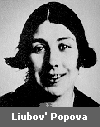

 |
"Representation of reality -- without artistic deformation and transformation -- cannot be the subject of painting." |
Liubov' Sergeevna Popova was one of the most talented, prolific, and influential women artists of the Russian avant-garde. She was born in the village of Ivanovskoe in Moscow province, in a family of a wealthy and cultured merchant. After attending the private high schools of Yaltinskaia and Arsen'eva, she began to take art lessons with Zhukovskii and Yuon in Moscow. In 1910, Popova went to Italy and became acquainted with the works of Giotto and Pintoriccio. The rest of that year and in 1911, the artist traveled to St. Petersburg, Rostov, Yaroslavl, Suzdal, Pereslavl, and Kiev and discovered the work of Vrubel and icon painting. In 1912, she set up a studio in Moscow with N. Udal'tsova, her friend from Arsen'eva's school, and both women worked in Tatlin's studio The Tower, where Popova met her life-long friend Vesnin. The same year she traveled to Paris and studied Cubism with Le Fauconnier and Metzinger. After returning to Moscow in 1913, she became interested in Futurism. A year later, just before the war, she went to France and Italy again. In 1915, she developed her own variant of non-objective art based on a dynamic combination of principles of icon painting (flatness, linearity) and avant-garde ideas.
In 1916, Popova started calling her compositions "Painterly Architectonics." She became a member of Supremus, organized by K. Malevich. Two years later, she married Boris von Eding, a Russian art historian, and gave birth to a son. Together with Vesnin, she started teaching at Svomas (Free Art Studios) and later (after 1920) taught at Vkhutemas (Higher Art-Technical Studios). During a trip to Rostov on the Don in 1919, Eding caught typhus and died. Though infected and suffering from typhoid fever, Popova returned to Moscow and recovered from the illness. In 1920, she worked at Inkhuk (Institute of Artistic Culture), a center of Constructivist theories. Over time, the construction elements in Popova's painting increased, progressing from Painterly Architectonics of 1916 to Painterly Constructions of 1920 and Painterly Force Constructions of 1921.
Painterly Architectonics show Popova's interest in the presentation of surface planes with an energy of inner tension, as the colored masses, lines and volumes all interrelate to create a formal unity. Initially they took the form of fairly static compositions comprising overlapping planar forms, but very soon they acquired a startling dynamism as Popova tilted the planes at angles and made them slice into each other. Painterly Constructions further developed the idea of intersecting planes, but gave the compositions a feeling of greater freedom and fluidity. Finally, her Spatial Force Constructions were supposed to be preparatory experiments towards concrete material constructions (After Yablonskaia, 103-104).
The artist's fascination with construction allowed her to join other constructivists in absolute rejection of easel painting. She gave up her own painting and turned entirely to industrial design (1921). A year before her untimely death, Popova was appointed head of the Design Studio at the First State Textile Print Factory in Moscow. She excelled in industrial design of clothing and fabrics and produced posters, book designs, ceramics, and photomontages.
Popova participated in many famous avant-garde exhibitions in Moscow and St. Petersburg (Petrograd): Jack of Diamonds (Moscow, 1914 and 1916), Tramway V / First Futurist Exhibition of Paintings (Petrograd 1915), 0.10 / Last Futurist Exhibition of Paintings (Petrograd 1915), The Store (Moscow, 1916), 5 x 5 = 25 (with Rodchenko, Stepanova, Vesnin and Exter), and others. In addition, she was successful as a set designer for theatre. Her first scenic designs were for Tairov's production of Romeo and Juliet (1920). Even though these designs were not used by Tairov, Popova's interest in stage design did not wane. The following year, she created the sets for Lunacharsky's The Locksmith and the Chancellor and in 1922 for Vsevolod Meyerhold's productions of Crommelynck's Magnanimous Cuckold. She continued her collaboration with Meyerhold, preparing sets for S. Tretiakov's Earth in Turmoil (1923). Her life was cut short in 1924 when she contracted scarlet fever and died at the age of 35. [E.P. and A.B.]
[Sources: Gray, The Avant-Garde in Russia, Russian Avant-Garde Art, Sarabianov, Yablonskaia.]
